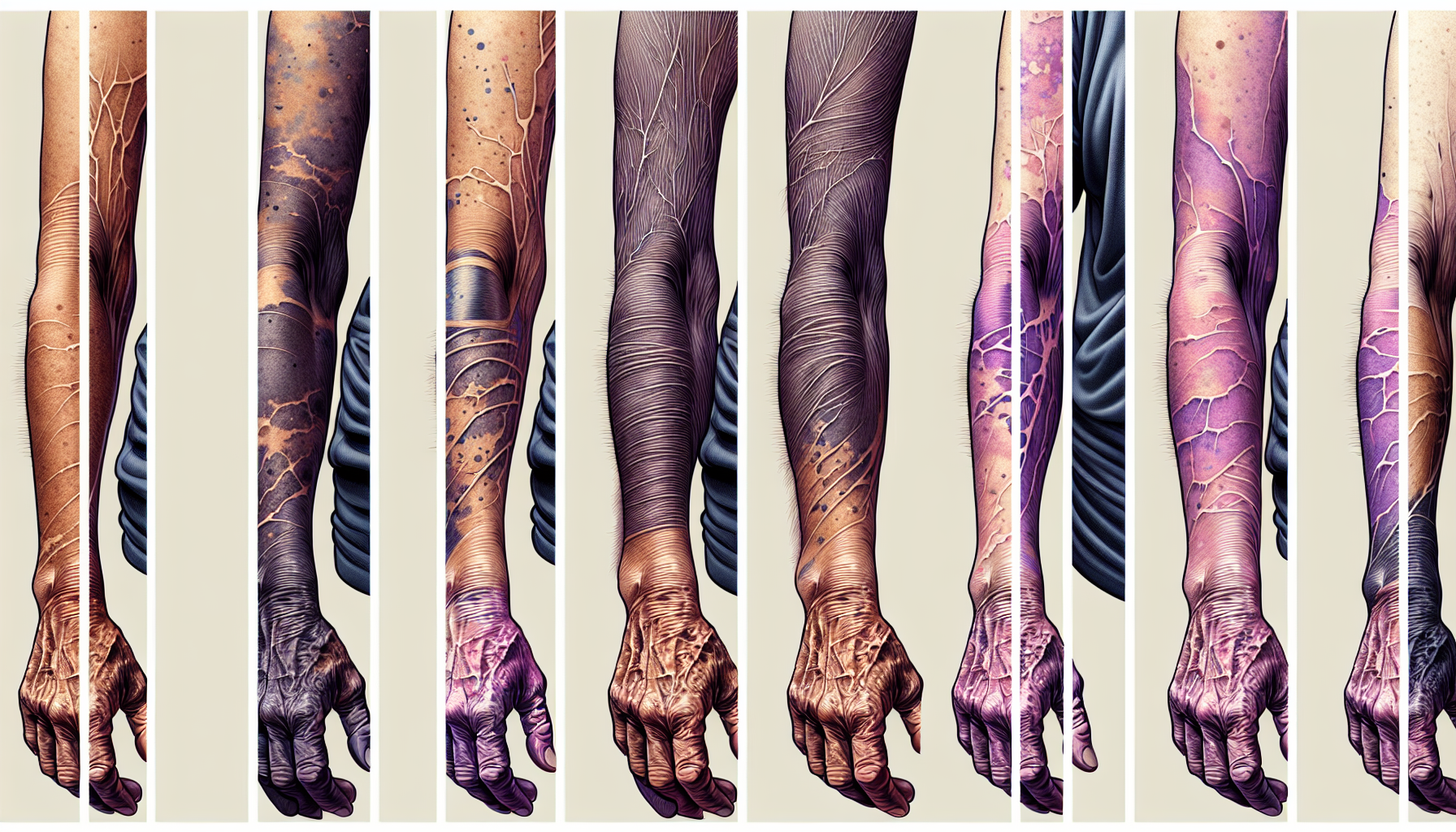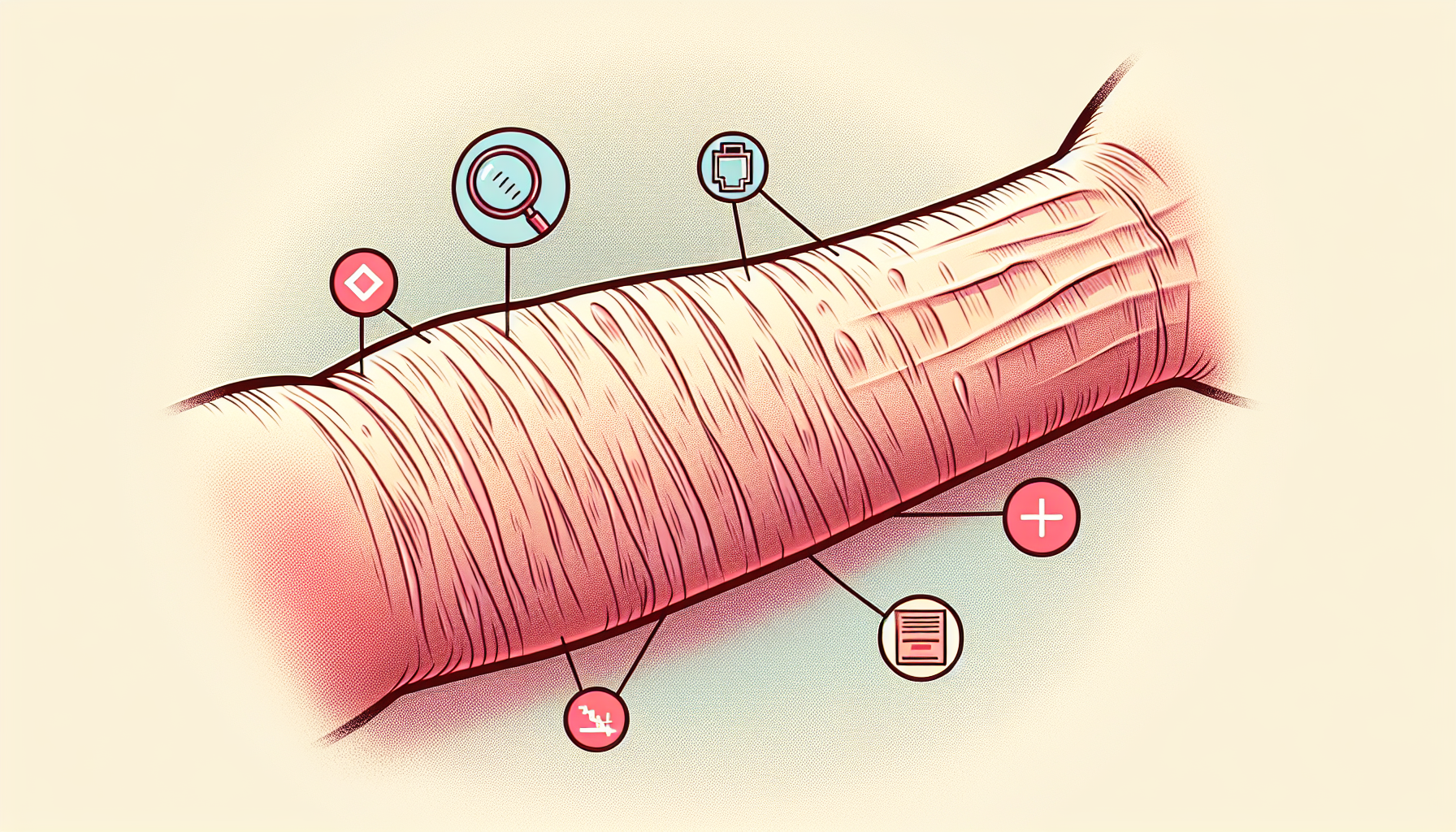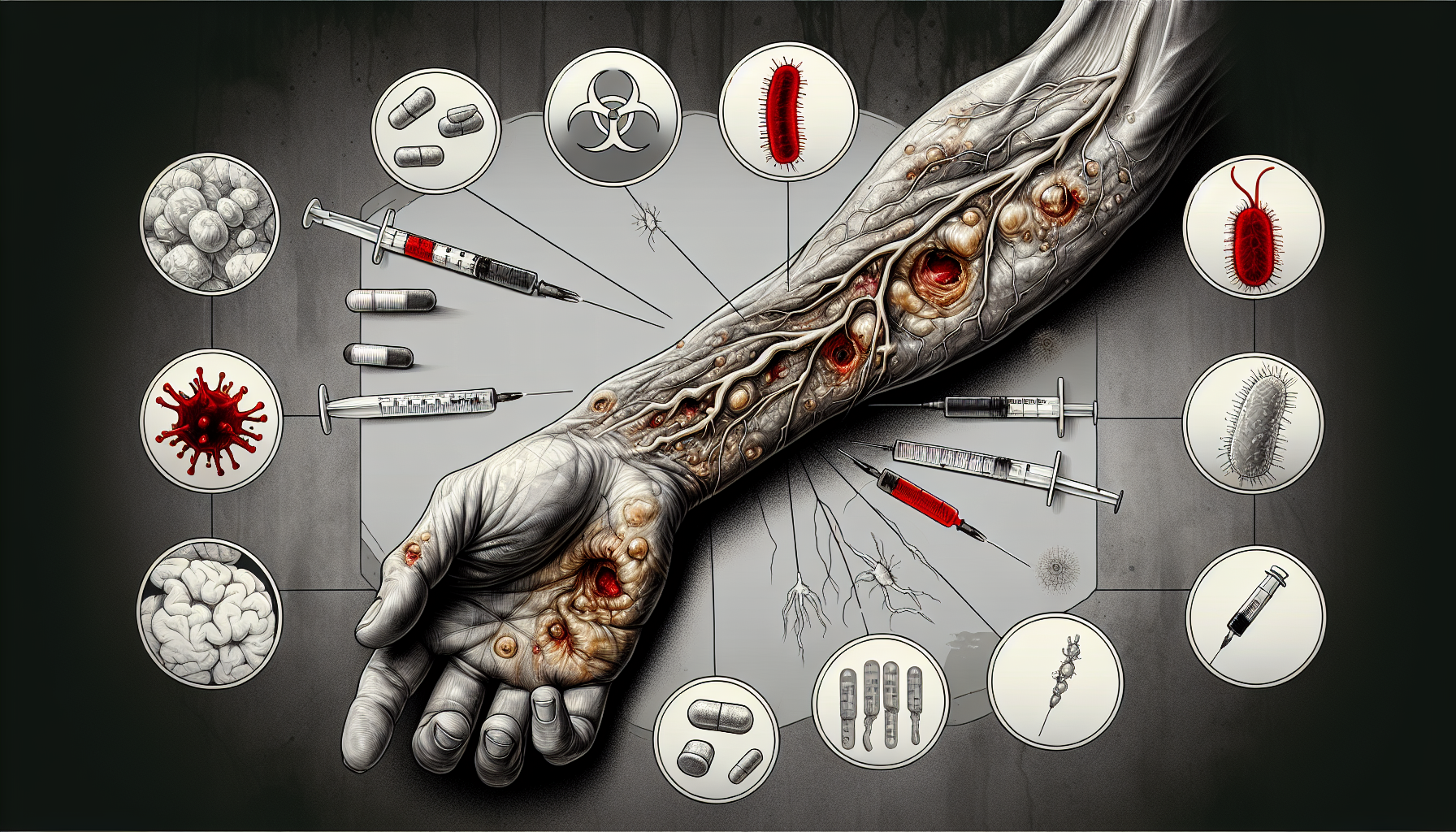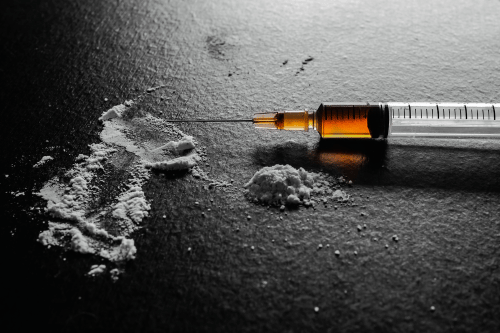Understanding Heroin Track Marks: Identification and Prevention
Heroin track marks are small puncture wounds or scars from injecting the drug. They are often found on the arms, legs, and other parts of the body. Recognizing these marks helps in identifying heroin use early. This guide explains what heroin track marks look like and why spotting them is essential for effective intervention.
Key Takeaways
Track marks, resulting from intravenous drug use, serve as critical indicators of heroin addiction and necessitate immediate intervention.
Identifying the physical and behavioral signs of heroin use can facilitate early detection and prompt support for individuals struggling with addiction.
Preventing track marks and relapse primarily involves abstaining from intravenous drug use and accessing necessary medical and emotional support.
Understanding Heroin Track Marks: Identification and Prevention

Track marks, also known as venipuncture marks, are small puncture wounds or scars resulting from intravenous drug use, particularly heroin. These marks often indicate a severe drug dependency that demands immediate attention. Track marks complicate treatment options, so early identification is crucial for effective intervention.
Identifying heroin track marks involves recognizing physical signs and understanding the broader context of heroin addiction. These marks are a significant indicator of drug abuse and can be a visual cue that prompts necessary conversations about addiction treatment and prevention.
Introduction
Heroin, often mixed with substances like sugar or powdered milk, can leave behind telltale signs on the body of those who use it intravenously. These signs, known as track marks, are more than just physical indicators—they are a window into the health and well-being of the user. Understanding these marks is crucial for early identification and prevention of substance abuse.
The journey of heroin addiction is often hidden in plain sight. Track marks are a significant indicator of intravenous drug use, and recognizing them can be a lifeline for those struggling with addiction. Knowing what these marks look like, where they appear, and the associated health risks helps better support individuals in recovery.
This guide aims to shed light on heroin track marks, their identification, and prevention. This guide aims to inform for timely intervention and effective treatment, ultimately saving lives.
What Are Heroin Track Marks?

Track marks, medically known as venipuncture marks, are small puncture wounds or scars resulting from the repeated use of needles to inject drugs into the veins. They are commonly associated with intravenous drug use, particularly with substances such as heroin, cocaine, and methamphetamine. These marks can be a clear indicator of heroin addiction and are often difficult to get rid of, further complicating treatment options.
Recognizing track marks is crucial for helping individuals battling heroin addiction. These marks not only indicate current drug use but also signal a pattern of behavior that needs immediate intervention. Early identification allows for exploring effective heroin addiction treatment and preventing further health complications.
Identifying Track Marks
Track marks are typically small puncture wounds that appear as bruises or scars, often scabbing over due to repeated injections. These marks can be found in various locations on the body, depending on where the individual injects the drug. Fresh track marks often appear as bruises or fresh lesions, while older track marks look like scars or discolored patches of skin.
Identifying track marks can be challenging, especially when individuals go to great lengths to hide them. Common injection sites include hidden areas such as the neck and groin, where users might inject to avoid detection. These signs indicate frequent needle use and a potential need for immediate help.
Common Injection Sites
Common injection sites for heroin users include the arms, wrists, and legs. However, track marks are not limited to these areas; they can also be found on the hands, neck, and legs. The choice of injection site often depends on the individual’s ability to access veins and their desire to hide the marks from others.
The physical signs at these injection sites can include scar tissue, bruising, and redness. Frequent injections in the same location can lead to significant skin damage and increase the risk of infections. Track marks in these areas often indicate a serious addiction that requires professional treatment.
Visual Characteristics of Heroin Track Marks

Track marks can vary in appearance depending on how long the individual has been injecting drugs. Initially, they may appear as small holes that are bright red or pink, which can evolve into scabs and eventually scars. These physical signs are often a clear indication of intravenous drug use.
Knowing the visual characteristics of track marks helps in early recognition of heroin addiction. By distinguishing between the initial appearance and long-term signs, we can better identify individuals who need help and support in their recovery journey.
Initial Appearance
Fresh track marks from heroin use typically appear as small red needle marks. These marks can be accompanied by swelling and bright red puncture wounds. In some cases, they may also appear as fresh lesions, scabs, or bruises that have not yet healed.
These initial physical signs can be alarming and may indicate recent drug use. Fresh track marks call for timely intervention and support for individuals struggling with heroin addiction.
Long-Term Signs
Over time, track marks can take years to fade and often evolve into darkened skin pigmentation, bruising, lesions, and scarring. Older track marks may show up as pale scars or discolored patches where the skin has healed. Users often change injection sites when veins become damaged, leading to more visible marks in areas like the neck and hands.
These long-term signs highlight the severity of drug use and potential health risks. These marks indicate a history of intravenous drug use and the need for comprehensive addiction treatment.
Health Risks from Intravenous Drug Use

Intravenous drug use poses significant health risks, both localized and systemic. Track marks can indicate a pattern of chaotic drug use, leading to severe health complications. Frequent intravenous drug use is associated with infections, disease transmission, vein and skin damage, and blood clots.
Using old or shared needles can exacerbate these health risks, increasing the likelihood of infections, abscesses, and mental health issues. These risks highlight the need for comprehensive medical and psychological support for individuals battling heroin addiction.
Localized Health Issues
Localized health issues at injection sites can include infections, lesions, and ulcers. Signs that medical treatment may be necessary for injection site reactions include discoloration, redness, and warmth around the area. Injecting in less common areas, such as the neck or groin, can increase the risk of serious complications and infections.
Recurrent intravenous heroin use can lead to collapsed veins, reduced blood flow, and severe infections. Compromised circulation from intravenous drug use can result in severe health conditions, including strokes and heart attacks.
These localized health issues necessitate timely medical intervention to prevent further complications.
Systemic Health Risks
Systemic health risks from intravenous drug use include the transmission of HIV, hepatitis B, and C through non-sterile needle use. Using dirty needles for heroin use can lead to serious infections, HIV/AIDS, and deep vein thrombosis. Complications from intravenous drug use include damaged veins, compromised blood flow, and blood clots. Additionally, injection drug use can exacerbate these health risks.
Compromised circulation from injecting drugs is linked to an increased risk of life-threatening conditions. These include deep vein thrombosis, stroke, and heart attack. Using heroin over a long period can result in damage to veins and skin. It can also heighten the risk of developing blood clots.
These systemic health risks underscore the need for comprehensive medical and psychological support for individuals struggling with heroin addiction.
Healing and Treatment for Track Marks
Healing from heroin track marks requires a combination of medical treatment and support for the underlying addiction. Treatment is essential for addressing both physical and psychological effects of addiction. Professional help is essential for assessing and addressing infections or complications, providing treatment options, and promoting healing.
Effective treatment centers are crucial for overcoming substance abuse, and immediate medical intervention is needed when signs of infection appear. Recovery support services such as intensive outpatient programs (IOPs) and partial hospitalization programs (PHPs) can be accessed for assistance.
Recovery Process
The recovery process from heroin addiction involves several steps. Abstaining from drugs is vital for healing track marks and overall recovery. Medical detox is the initial step for anyone with a history of intravenous drug use to safely remove drugs and manage withdrawal symptoms.
Individuals should seek immediate medical attention and emotional support when they notice visible signs of heroin abuse. Physical health and diet significantly influence the healing of track marks. Following up with medical professionals to address injection site reactions is necessary. This will help ensure a complete recovery.
Medical Treatments
Medical treatments for track marks include professional intervention to prevent complications from IV drug use. Plastic or vascular surgeons can evaluate damaged veins from intravenous drug use. Scar reduction products can be effective for newer track marks but may have limited results.
Medication-assisted treatment, cognitive behavioral therapy (CBT), dialectical behavior therapy (DBT), holistic therapies, and family therapy are types of therapies included in the treatment for drug addiction. Healthcare providers can offer a personalized recovery plan tailored to an individual’s needs, ensuring comprehensive care and support.
Recognizing Broader Signs of Heroin Use
Recognizing broader signs of heroin use is crucial for early intervention. Besides visible track marks, common behavioral changes in individuals using heroin can include becoming more secretive, social isolation, and locking doors to hide their activities. These signs indicate a deeper issue that requires attention and support.
Signs of drug abuse that may indicate heroin use include isolation, weight gain or loss, and noticeable changes in behavior. These broader drug addiction signs help in providing timely intervention and support to individuals struggling with addiction.
Behavioral Indicators
Behavioral changes among heroin users can include mood swings and a secretive lifestyle where the individual may avoid discussing their activities. Social withdrawal is a common behavior among heroin users. Increased secrecy and avoidance of friends and family can indicate heroin use.
These behavioral changes highlight the need for early intervention in heroin addiction. By identifying these signs, we can offer the necessary support and help individuals on their path to recovery.
Physical Symptoms
Additional physical symptoms of heroin addiction include unexplained weight loss and poor personal hygiene. Unexplained weight loss often accompanies heroin use. Poor personal hygiene can be a physical indicator of heroin addiction.
These physical symptoms necessitate timely intervention and comprehensive support for individuals struggling with heroin addiction.
Preventing Track Marks and Relapse

Before: Preventing track marks and relapse involves avoiding intravenous drug use and seeking help for addiction. Abstaining from intravenous drug use is the only way to prevent track marks. Avoiding repeated injections in the same spot and seeking help for addiction can prevent new track marks.
After: Preventing track marks and relapse involves:
Avoiding intravenous drug use, as abstaining is the only way to prevent track marks.
Avoiding repeated injections in the same spot.
Seeking help for addiction to prevent new track marks.
Medical and emotional support is crucial for individuals with track marks to ensure comprehensive recovery. Recognizing signs of heroin use helps prevent overdose and ensures proper intervention.
Avoiding Intravenous Drug Use
Abstaining from intravenous drug use is the most effective way to prevent track marks. This helps individuals avoid physical signs of drug abuse, such as mood swings and poor performance, indicating the need for IV drug treatment. Rotating injection sites can help minimize the risk of developing scar tissue and track marks, although this is only a temporary solution and does not address the root cause of addiction.
Maintaining a supportive environment and avoiding triggers are essential strategies for abstaining from intravenous drug use. This involves creating a network of supportive friends and family, avoiding situations that may lead to drug use, and seeking professional help when needed. These steps help reduce the risk of developing track marks and promote a healthier, drug-free life.
Support Systems and Rehabilitation
Engaging in rehabilitation services significantly improves the likelihood of long-term recovery from addiction. Participating in self-help groups can provide individuals with community support and shared experiences in recovery. These groups offer a sense of belonging and understanding, which can be crucial for maintaining sobriety and preventing relapse.
Support systems such as addiction treatment centers, counseling services, and family therapy are essential components of the recovery process. These resources help individuals develop coping strategies, address the root causes of addiction, and provide a structured environment for recovery. By utilizing these support systems, individuals can navigate the challenges of addiction and work towards a healthier, more fulfilling life.
Summary
Heroin track marks are a visible and alarming sign of deeper issues related to drug abuse and addiction. Recognizing these marks and understanding their implications is crucial for early intervention and effective treatment. The visual characteristics of track marks, including their initial appearance and long-term signs, provide important clues about an individual’s drug use history and the severity of their addiction.
Addressing the health risks associated with intravenous drug use, both localized and systemic, is essential for preventing further complications. Healing and treatment for track marks require a combination of medical intervention and emotional support, with a focus on comprehensive recovery. By recognizing broader signs of heroin use and utilizing support systems and rehabilitation services, individuals can work towards preventing track marks and achieving long-term sobriety. Together, we can help those battling heroin addiction find the path to recovery and a brighter future.
FAQ's
Heroin track marks typically present as small puncture wounds or scars, often appearing as bright red fresh wounds or discolored patches of skin as they age. It’s important to recognize these signs for the sake of health and safety.
Common injection sites for heroin users are the arms, wrists, and legs, with additional spots including the hands, neck, and groin. These areas are selected for their accessibility and the ability to conceal visible track marks.
Intravenous drug use significantly increases the risk of serious health issues such as infections, abscesses, vein damage, HIV, hepatitis B and C, and blood clots, especially when using old or shared needles. It is crucial to recognize these dangers to prioritize health and safety.
Track marks can be treated through medical intervention to manage infections, the use of scar reduction products for newer marks, and engaging in comprehensive addiction treatment programs that include medication-assisted therapy and various therapeutic approaches.
To effectively prevent track marks and relapse, abstaining from intravenous drug use is essential. Additionally, maintaining a supportive environment, avoiding triggers, and seeking professional help through rehabilitation services play a critical role in achieving long-term sobriety.









